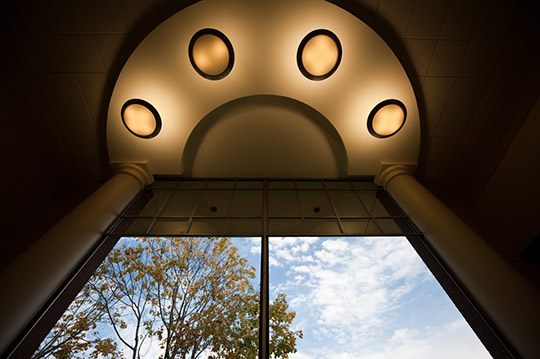With paper-and-binder books taking up shelves and collecting dust, it’s time for them to go — these days students learn in more collaborative ways and through systems involving modern technology. Are books gone forever? No, they’re just online.
Photo by Madelyn Shotton
These paperback books are slowly exiting the library. More than 30,000 volumes are being removed. Today, the library faculty and staff members work each day cycling through each book to determine what to keep and what to say goodbye to.
__________________________________________________
“One of the things that is changing rapidly in higher education is library space. Students learn differently now,” said Dr. Keith Ross, university president. “I’m a book person anyways, so I like books, but what we found out is that a great number of the volumes we have there haven’t been checked out in years.” The way that students learn is rapidly changing, and professors and other educators have begun to notice. The Library Task Force, a group of faculty and staff members from MBU who are studying what students need in their new library, are asking students, looking at other university libraries and researching studies on the new era of students. “It [the new library space] would represent a new era of intellectual engagement for Missouri Baptist University. Research has shown that more people, students and professors research online and frequently work in groups. The renovation would allow for both social and study spaces,” Amanda Staggenborg, assistant professor and undergraduate communications instructional coordinator, and a member of the Library Task Force, said in an email. In the fall semester of 2016, once the decision was made that the library was indeed getting a renovation, Ross began looking at his options, dollar-wise. “We approached a donor and said, ‘Hey if we could do this, would you be interested?’ We have a substantial lead gift that will help us with this. We still need to do some additional fundraising. When we got that gift we knew we could start moving forward with some ideas,” Ross said. The preliminary total cost of the project is approximately $1.2 million and the lead gift totaled $500,000. The donor, at this time, will remain anonymous, Ross said. Next, Ross began the journey by taking university vice presidents with him to visit William Jewell College in Liberty, Missouri, to look at their Pryor Learning Center, a building that contains innovation and active learning spaces, which is where a lot of MBU’s ideas came from. “We were seeing where there’s new, different, innovative collaborative learning environments. Many of them were associated with schools moving away from the traditional library,” said Ross. A non-traditional library is going to contain more technology, private rooms for groups of students to work together, and some creative spaces in general. “We were excited to see the best practices in library technology at Maryville University and Lindenwood University. People were not simply retrieving information but socializing, researching and supporting students in collaborative hubs,” Staggenborg said in an email. “Lots of open spaces and study areas, nooks and ground-floor cafes. But almost every seat was occupied, which was inspiring.” After viewing Maryville and Lindenwood’s libraries, the Library Task Force had a more clear understanding of what elements in Jung-Kellogg need updating. “The library renovation itself is wanting to focus on creating more collaborative study spaces for students, kind of thinking how our library space is being used,” said Jeanna Ryner, director of library services at MBU from February 2016 to August 2018. “We aren’t looking to build on to the building at all, we are looking at just the existing floor plan as it is and how can we repurpose that for our students in the coming years.” One of the first steps of beginning the renovation is clearing some of the current space to make room for new elements such as more group working stations, “living-room-like” spaces, and small, closed-off rooms for collaborating. “Part of the project itself is a large space for a reclamation project, so we need space, to create space for the students. A big part of this project is that space reclamation effort and for the library what that means is that we are looking at downsizing our print collection by about 70 percent,” Ryner said last year during the project’s beginning. Rebekah McKinney, current director of library services, said the library staff began removing books from the physical circulating collection in May 2018 and are now nearing completion of that effort. This physical circulating collection contains the books that are currently in the library and available for checkout. On a daily basis, McKinney said library staff members are working diligently at checking and removing items from their physical circulating collection in a timely manner. “I am also looking forward at the other collections that must be downsized in order to create the maximum amount of space for the renovation,” McKinney said. When deciding what to keep and what to remove from the library, the Library Task Force is focusing on which books regularly circulate and which books haven’t been checked out in years. Items that are outdated or have not circulated at all will no longer have a place in the library, officials said. Photo courtesy of MBU Communications “We are trying to make a point to keep or retain some of those items that are unique to our library,” said Ryner. For example, the library plans to keep its large music and Bible ministry collections. The Library Task Force is still deciding where the removed books will physically go, and are concerned that students or community members will have no interest because of the books’ age. Once library officials receive final approval on how the books can be handled, they will communicate that with faculty and students. “It is still undecided what the space will look like at the very end of things. We aren’t looking to bring on a computer lab, necessarily, but we are looking to upgrade the technology that is available in the space now,” said Ryner. Instead of the 19 computers in the front, students could see things like large group study tables with a computer screen to work from, small closed-off group study spaces and more intuitive spaces to work in and collaborate. “There will be video monitors on some walls, so if you can imagine eight or 10 students sitting around a table that they might use that for collaborative learning,” said Ross. In addition, there will be charging stations for laptops, mobile whiteboards, collaborative spaces and quiet rooms for students to edit video and sound projects. “Spaces that would resemble a living room setting; overstuffed furniture, those kinds of things,” said Ross. Though it is too far in advance to plan a grand opening event, when the Library Task Force has a firm idea of what the library will look like they plan to post some sketched displays, almost blue-print-like, in the front of the current library and in the Great Hall to give students a visual of the coming changes. “We wanted the faculty and staff to say, ‘Yeah, if we had this space I would maybe change my syllabus, make them a little more up to date, maybe there’s a different way to do learning,’” said Ross. With the new space and new technology being added, faculty and staff members would begin considering changing parts of their syllabi because MBU now will have the resources for students to create and complete different types of assignments. “I am most excited about the creation of collaborative spaces for students to work together. As someone who knows the importance of collaboration, I believe this is an essential component in helping our students achieve success in the classroom,” McKinney said in an email. Staggenborg thinks students will be pleased with the changes. “They will be able to obtain all of the resources they need in a study-friendly environment while feeling like they are in a living room,” she said. Students are encouraged to submit any ideas or suggestions they have about the renovation or leave a response in the suggestions box at the library front desk. “Just from informal conversations that I’ve had with students on campus, it seems like these are the types of spaces that they are most interested in,” said Ryner. “I think they [students] will have some pride in it.” University officials are hopeful that students will carry pride in their new library and Ross said he believes students will want to be in the building more. “This is going to be a great project. I think it will expand greatly the learning opportunities for our students. It will be a place that they will want to go, and feel comfortable going,” said Ross.
